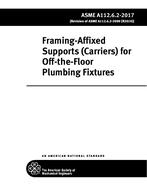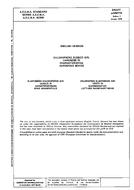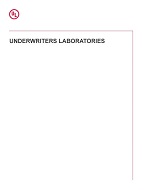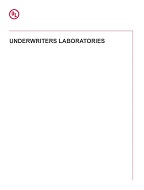Category
Recently Viewed Products
-
 ASME TDP-2
ASME TDP-2
$55.00$33.00 -
 UL Subject 2261
UL Subject 2261
$250.00$150.00 -
 ASME A112.6.2
ASME A112.6.2
$75.00$45.00 -
 UL 1017
UL 1017
$631.00$378.60 -
 ASD-STAN prEN 2112
ASD-STAN prEN 2112
$16.01$9.61
UL 10B
$631.00 $378.60
Fire Tests of Door Assemblies
| Published by | Publication Date | Number of Pages |
| UL | 02/07/2008 | 28 |
UL 10B – Fire Tests of Door Assemblies
Please note: All interim revisions for this edition available at time of your purchase will be included.
Fire Tests of Door Assemblies
UL 10B
1 Scope
1.1 These methods of fire tests are applicable to door assemblies of various materials and types of construction for use in wall openings to retard the passage of fire.
1.2 Tests made in conformity with these test methods register performance during the test exposure; and such tests shall not be construed as determining compliance for use after exposure to fire.
1.3 It is the intent that tests made in conformity with these test methods develop data to enable regulatory bodies to determine the compliance of door assemblies for use in locations where fire resistance of a specified duration is required.
1.4 These methods are intended to evaluate the ability of a door assembly to remain in an opening during a predetermined test exposure.
1.5 The tests expose a specimen to a standard fire exposure controlled to achieve specified temperatures throughout a specified time period, followed by the application of a specified standard fire hose stream. The exposure, however, is not representative of all fire conditions, which vary with changes in the amount, nature, and distribution of fire loading, ventilation, compartment size and configuration, and heat sink characteristics of the compartment. It does, however, provide a relative measure of fire performance of door assemblies under these specified fire exposure conditions.
1.6 Any variation from the construction or conditions that are tested is capable of substantially changing the performance characteristics of the assembly.
1.7 The methods do not provide the following:
a) Full information as to performance of all door assemblies in walls constructed of materials other than those tested.
b) Evaluation of the degree by which the door assembly contributes to the risk of fire by generation of smoke, toxic gases, or other products of combustion.
c) A temperature limit on the unexposed side of the door assembly.
d) A limit on the number of openings intended in glazed areas or of the number and size of lateral openings between the door and frame.
e) Measurement of the degree of control or limitation of the passage of smoke or products of combustion through the door assembly.
Product Details
- Edition:
- 10th
- Published:
- 02/07/2008
- Number of Pages:
- 28
- Note:
- This product is unavailable in Ukraine, Russia, Belarus
Related products
-
UL 977
$897.00$538.20Add to cartFused Power-Circuit Devices
Published by Publication Date Number of Pages UL 04/30/2012 73 -
UL Subject 9703
$250.00$150.00Add to cartOutline of Investigation for Distributed Generation Wiring Harnesses (Outline, 8/2/2011)
standard by Underwriters Laboratories, 08/02/2011 -
UL 987
$998.00$598.80Add to cartStationary and Fixed Electric Tools
Published by Publication Date Number of Pages UL 10/19/2011 230 -
UL 971
$502.00$301.20Add to cartNonmetallic Underground Piping for Flammable Liquids
Published by Publication Date Number of Pages UL 10/30/1995 52
UL 10B
$885.50 $531.30
Fire Tests of Door Assemblies
standard by Underwriters Laboratories, 04/28/1997
Please note: All interim revisions for this edition available at time of your purchase will be included.
By order of the publisher, historical UL documents are not returnable for any reason. Once you place an order for an historical document, we cannot issue a refund, credit, or exchange of any kind.
These methods of fire tests are applicable to door assemblies of various materials and types of construction for use in wall openings to retard the passage of fire.
Tests made in conformity with these test methods register performance during the test exposure; and such tests shall not be construed as determining compliance foruse after exposure to fire.
It is the intent that tests made in conformity with these test methods develop data to enable regulatory bodies to determine the compliance of door assemblies for usein locations where fire resistance of a specified duration is required.
These methods are intended to evaluate the ability of a door assembly to remain in an opening during a predetermined test exposure.
The tests expose a specimen to a standard fire exposure controlled to achieve specified temperatures throughout a specified time period, follow ed by the applicationof a specified standard fire hose stream. The exposure, however, is not representative of all fire conditions, which vary with changes in the amount, nature, anddistribution of fire loading, ventilation, compartment size and configuration, and heat sink characteristics of the compartment. It does, however, provide a relativemeasure of fire performance of door assemblies under these specified fire exposure conditions.
Product Details
- Edition:
- 9th
- Published:
- 04/28/1997
- Number of Pages:
- 45
- Note:
- This product is unavailable in Ukraine, Russia, Belarus
Related products
-
UL 98
$502.00$301.20Add to cartEnclosed and Dead-Front Switches
Published by Publication Date Number of Pages UL 02/12/2016 0 -
UL Subject 1588
$250.00$150.00Add to cartOutline of Investigation for Roof and Gutter De-Icing Cable Units (Outline, 5/24/2002)
standard by Underwriters Laboratories, 05/24/2002 -
UL Subject 2806
$250.00$150.00Add to cartOutline of Investigation for Heavy Duty Flexible Power Cable (Outline, 12/7/2015)
standard by Underwriters Laboratories, 12/07/2015 -
UL Subject 2011
$250.00$150.00Add to cartOutline for Factory Automation Equipment (Outline, 5/1/1995)
standard by Underwriters Laboratories, 05/01/1995



